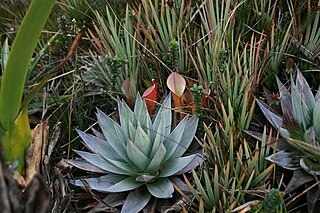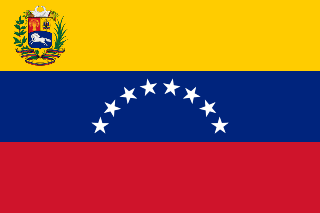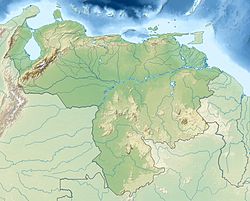
Heliamphora folliculata is a species of Marsh Pitcher Plant endemic to the Aparaman group of tepuis in Venezuela. It grows on all four mountains: Aparaman Tepui, Murosipan Tepui, Tereke Tepui and Kamakeiwaran Tepui.

Heliamphora heterodoxa is a species of marsh pitcher plant native to Gran Sabana and the plateau of Ptari Tepui in Venezuela. It was first discovered in 1951 upon Ptari Tepui. This Heliamphora is closely related to H. glabra and the latter was for a long time considered a form of H. heterodoxa. It is one of four Heliamphora taxa formally described by Julian A. Steyermark.

Heliamphora minor is a species of marsh pitcher plant endemic to Auyán-tepui in Venezuela. As the name suggests, it is one of the smallest species in the genus. It is closely related to H. ciliata and H. pulchella.

Upuigma-tepui, also known as El Castillo, is a tepui in Bolívar state, Venezuela. A relatively isolated peak, both it and nearby Angasima-tepui lie just south of the vast Chimantá Massif, from which they are separated by the Río Aparurén valley. Upuigma-tepui is situated entirely within the bounds of Canaima National Park.

The natural range of the carnivorous plant genus Heliamphora is restricted to the southern Venezuelan states of Amazonas and Bolívar, and to adjacent portions of northern Brazil and western Guyana, an area corresponding to the western part of the Guayana Shield. These plants are largely confined to the summits and foothills of the sandstone table-top mountains of the region, known as tepuis.

Cerro Huachamacari, also spelled Huachamakari or Kushamakari, is a tepui in Amazonas state, Venezuela. It lies northwest of the giant Cerro Duida and the other peaks of the Duida–Marahuaca Massif, and is considerably lower at only around 1,900 metres (6,200 ft).

Aprada-tepui is a tepui in Bolívar state, Venezuela. It has an elevation of around 2,500 metres (8,200 ft) above sea level. It gives its name to the Aprada Massif, which also includes the smaller Araopán-tepui to the east. A steep, semi-circular ridge connects these two summits. Aprada-tepui lies 22 kilometres (14 mi) northwest of the much larger Chimantá Massif and around 25 km (16 mi) east of the Pemón village of Urimán.

Araopán-tepui is a tepui in Bolívar state, Venezuela. It has an elevation of around 2,450 metres (8,040 ft) above sea level. Together with the larger Aprada-tepui to the west, it forms part of the Aprada Massif. A steep, semi-circular ridge connects these two summits.

The Chimantá Massif is a highly fragmented complex of tepuis in Bolívar state, Venezuela. The massif comprises around 11 tepuis and has a total summit area of 615 km2 (237 sq mi) and an estimated slope area of 915 km2 (353 sq mi). It is divided in two by the Río Tírica, with the northern section being both larger and higher. The massif is notable for its high species richness and for its varied habitat types. It reaches an elevation of 2,698 metres (8,852 ft) on its highest peak, Murey-tepui. The massif is situated entirely within the bounds of Canaima National Park. It hosts extensive cave systems, including the world's largest known quartzite cave, Cueva Charles Brewer, named after discoverer Charles Brewer-Carías. The processes behind their speleogenesis are the subject of some debate.

Uei-tepui, also known as Wei-tepui, Cerro El Sol or Serra do Sol is a tepui on the border between Brazil and Venezuela. It may be considered the southernmost member of the Eastern Tepuis chain.

Aparamán-tepui is the westernmost of the four main tepuis of the Los Testigos chain in Bolívar, Venezuela. While the other three tepuis share a common slope area, Aparamán is derived from a separate basement. Aparamán-tepui has an elevation of around 2,100 metres (6,900 ft), a summit area of 1.25 km2 (0.48 sq mi), and an estimated slope area of 28 km2 (11 sq mi). Its mostly bare summit plateau is highly dissected, presenting difficulties even for helicopter landings.

Murisipán-tepui, also spelled Murosipán or Murochiopán, is one of the four main tepuis of the Los Testigos chain in Bolívar, Venezuela. Looking west to east, it is the second major peak of the massif and is connected to the next two—Tereke-yurén-tepui and Kamarkawarai-tepui—by a common basement. Murisipán-tepui has an elevation of around 2,350 metres (7,700 ft) and a summit area of 5 km2 (1.9 sq mi). The mountain's mostly bare summit plateau has a small, seasonal lagoon near its centre.

Tereke-yurén-tepui is one of the four main tepuis of the Los Testigos chain in Bolívar, Venezuela. Looking west to east, it is the third major peak of the massif and is connected to Murisipán-tepui and Kamarkawarai-tepui by a common basement. With a summit area of 0.63 km2 (0.24 sq mi) and an elevation of around 1,900 metres (6,200 ft), Tereke-yurén-tepui is both the smallest and lowest of the four peaks. Its summit plateau comprises mostly bare rock.

Angasima-tepui, also known as Adanta, Adankasima or Adankachimö, is a tepui in Bolívar state, Venezuela. A relatively isolated peak, both it and nearby Upuigma-tepui lie just south of the vast Chimantá Massif, from which they are separated by the Río Aparurén valley. Amurí-tepui, the closest member of the Chimantá Massif, is only 8 kilometres (5.0 mi) from Angasima-tepui.

The Eastern Tepuis, also known as the Roraima–Ilú range, is a mountain chain stretching for some 60 kilometres (37 mi) along the border between the disputed territory of Guayana Esequiba in Guyana, Venezuela and, to a small extent, Brazil. It runs in a northwesterly direction from the tripoint of these countries, closely following the Guyana–Venezuela border, with a single major peak (Uei-tepui) to the south, on the Brazil–Venezuela border. Moving northwest from Uei-tepui (2,150 m), the main summits of this chain are Roraima-tepui (2,810 m), Kukenán-tepui (2,650 m), Yuruaní-tepui (2,400 m), Wadakapiapué-tepui (2,000 m), Karaurín-tepui (2,500 ), Ilú-tepui (2,700 m), and Tramen-tepui. The minor peak of Wei-Assipu-tepui lies entirely outside Venezuela, on the border between Brazil and Guyana. Additionally, there are a number of minor plateaus which form a chain between Uei-tepui and Roraima-tepui. Ilú- and Tramen-tepuis are often treated together since they are joined by a common base.

Wadakapiapué-tepui, also spelled Wadakapiapö, Wadakapiapo, Wadaka Piapo or Guadacapiapui, is a tepui of the Eastern Tepuis chain in Bolívar, Venezuela. It has an elevation of around 2,000 metres (6,600 ft). Its tiny tower-like summit has an area of less than 0.01 km2 (0.0039 sq mi), making it the smallest member of the Eastern Tepuis. It lies just west of the much larger Yuruaní-tepui.

Yuruaní-tepui, also known by the Pemón name Iwalkarima, Iwalecalima or Iwarkárima, is a tepui of the Eastern Tepuis chain primarily situated in Venezuela, while part of the eastern ridge stretches into the disputed Guayana Esequiba territory in Guyana. It has an elevation of around 2,400 metres (7,900 ft), the high plateau being located entirely within Venezuela, and a summit area of 4.38 km2 (1.69 sq mi). It lies just east of the much smaller Wadakapiapué-tepui. This Tepui is not located in the Canaima National Park unlike most other Tepuis in the area.

Uaipán-tepui, also spelled Waipán, is a tepui in Bolívar state, Venezuela. It is a southern satellite peak of the vast Auyán Massif, with a maximum elevation of around 1,950 metres (6,400 ft). Its mostly forested summit plateau has an area of 2.5 km2 (0.97 sq mi). The mountain's slope area has been estimated at 60 km2 (23 sq mi).

Karaurín-tepui, also spelled Caraurín, is a tepui of the Eastern Tepuis chain in Bolívar state, Venezuela. It has a maximum elevation of around 2,500 metres (8,200 ft) above sea level. The summit plateau is covered by shrubby vegetation and has an area of 1.88 km2 (0.73 sq mi). The foothills of the tepui are covered in forests. Karaurín-tepui lies just south of the much larger Ilú–Tramen Massif.














